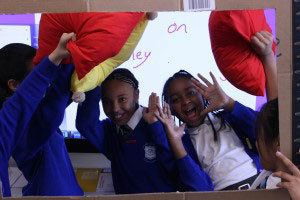Cultivate resources
Downloads
Planning a Cultivate creative project
This planning workbook sets out guidance put together to support the development of creative workshops that formed part of the Cultivate programme. The aim was to ensure that workshops were designed in order to meet the curriculum needs of schools as well as offering diverse creative experiences led by creative professionals.
Download Planning a Cultivate creative project
Exploring Nine Elms - 3 creative learning projects inspired by place
This downloadable resource shares the approaches of the Exploring Nine Elms projects, providing inspiration for teachers and creative practitioners to develop their own creative learning projects inspired by changing places. The detailed plans can be adapted to work for different age groups in different contexts and can link to different curriculum topics. They are also designed to be open for teachers/artists or young people to apply to their own ideas, needs or curriculum subjects.
Exploring Nine Elms was one of the first Cultivate projects to test approaches for cultural learning workshops. Three creative practitioners across the fields of fine art, architecture and design led workshops with three different schools in Nine Elms (two primaries and one secondary) during June and July 2016. The elements being piloted included:
- Testing the limits of the new Cultivate planning workbook, to see how it worked to help creative practitioners and educators plan and evaluate projects
- Comparing the approaches of three different types of creative practitioner, and how each could contribute to the needs of schools
- Reaching out to offer projects to schools that were interested in accessing creative learning focused on the local regeneration area
- The participation of developers and local cultural organisations
- Exploring and sharing innovative practice in exploring places, careers, creativity, design and the built environment with schools and young people.
Download Plans for 3 creative learning projects inspired by place
Creative professionals Q&A
Fatima Khuzem, Product and Spatial Designer
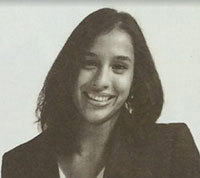
How do you describe what you do when someone in your family asks?
I am a product and spatial designer, and I use creativity to make/build things that can help address or solve problems.
What is the most interesting project you’ve worked on?
A project for Mumbai airport. The sheer scale of it was very exciting and it was the first of its kind that I worked on. It was designing all their passenger experiences in the arrival and departure zones – including all the physical things that went in it.
What aspect of your work gives you the best feeling?
Seeing the result of a project and talking to people that share the same sentiment.
What keeps you awake at night?
How I can balance having a lucrative career while doing the things I believe in and love. Also whether I will be a good mother.
What does your work now have to do with what you studied, if at all?
What I studied and continue to study act as stepping stones to refine myself as a person and in my work too. I still continue to be a designer like I studied to be. I use the same tools and knowledge but use them for all kinds of different things now.
What advice would you give to a young person interested in a career like yours?
My first advice would be that, there is no alternative to hard work. Doing anything different means having to fight for it. Secondly I would advise young people to start doing and making, as design and creativity is in everything. The easiest first step to take would be to start looking at people and things you find inspiring and try and replicate them. Keep a scrap book!
Anne Héloise Dautel, Architect
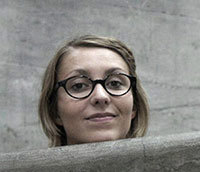
First question, how do you describe what you do when someone in your family asks?
I create and design spaces and buildings for people by sculpting and manipulating the light, volumes, etc. We all live in an ‘architectured’ world which has been designed and ‘dictated’ by planners and architects and I would like to sensibilise people to their surroundings and Architecture in general. Architecture is like a playground for me, or a laboratory where I manipulate volumes and materials, combine them, try to understand what the client’s wish is. Architecture should be a profession and a career of continuous research and personal development.
I have been working in the UK as an Architect for more than 4 years. I am currently employed and have been working in a Architecture firm based in Central London for nearly 2 years. Before that, I used to work in a Belfast based firm specialised in Conservation work. That Northern Irish company sent me to China for a 3 1/2 month business trip in Shenzhen in order to create a partnership with a Chinese local firm. I had the chance to work on masterplans on scales much bigger than anything I have worked on in Europe. I also had the opportunity to do some architectural research in the Architecture School of Bhopal in India while being part of a students exchange programme between Bhopal and Queens University of Belfast.
What is the most interesting project you have worked on?
A 5.3 hectare regeneration masterplan in Bangor, sea-side town in Northern Ireland. The final proposal includes a cultural, leisure and arts hub and theatre, located in the town centre, as well as shops, restaurants, offices and hotels – all of which acting as a catalyst for regeneration in the heart of the town. Its apartments and hotels put its residents first and will ensure this vibrant and diverse place has an enduring legacy. I have worked with the local residents closely to determine their needs and define the programme and space.
What aspect of your work gives you the best feeling?
Working with and for people.
What keeps you awake at night?
When I feel like I could have performed better and did not give the best of myself.
What does your work now have to do with what you studied, if at all?
I studied Architecture in France and Northern Ireland and am now an Architect.
Chelsea Moore, Scenic Art and Costume Design
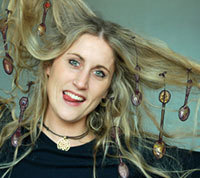
How do you describe what you do when someone in your family asks?
I am a designer and maker, specialising in creating set builds, installation art, scenic art, sculpture and costume. I work mostly in paint, fabrics and scrap materials that I source from Scrapstores around the country. Throughout my freelance career, I have actively sought out opportunities for creative events ranging from public events and festivals, and evolving my experience and passion as a workshop facilitator and maker for children’s theatre and community projects. I always find this a tough one, especially trying to describe what I do in one sentence because I do lots of different projects all the time.
What is the most interesting project you’ve worked on?
There are many exciting projects I have worked on that I have loved equally, but the one that probably stands out is a self-funded and crowd-funded project called Son Caméléon. This was the first multi-disciplinary project produced by the art collective I run, Tangleface Arts, also being the project that brought us together as a collective which is why it is special to me.
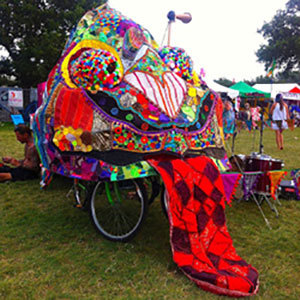
It was created in 2014 and has since toured music and arts festivals and events around the UK for three years running. Son Caméléon is an art installation that comes to life when in use – it is ultimately a pedalling stage that looks like a chameleon. The build itself ignites a childish sense of awe; a giant Mumma Caméléon emitting music, pedalling through the landscape accompanied by her chameleon offspring (these are performers dressed up in chameleon costumes that we made). Once Mumma Caméléon finds a suitable feeding ground, she parks up and welcomes you into her world of delights, fending off the enemy with her colourful displays of both live acoustic music and DJ sets. Son Caméléon comes with promenade-style performance, interactive games, handmade goods and prizes, as well as bookable art workshops bespoke to each event.
What aspect of your work gives you the best feeling?
Being hands on and making! I also massively enjoy facilitating workshops as this gives me great joy and pleasure passing on my love and skills set for art onto others, and I really enjoy working with other people – most of my work consists with collaborating.
What keeps you awake at night?
Being a freelancer means that my work brain is always switched on, so I guess if I am kept awake at night it is always because I am either thinking of my tasks for the next day, worrying if I have enough time to get everything done or the opposite of that and worrying when my next job will come in. It is definitely no 9-5 and can be extremely stressful but I wouldn’t want it any other way as it gives me a huge amount of freedom too!
What does your work now have to do with what you studied, if at all?
I studied Fine Art at university so my studies have definitely fed into what I am doing now. If I never went to the university I studied at (The Arts University Bournemouth), then I would never have met the people who I now run Tangleface Arts with and actually most of the people I collaborate now with on commissions. Fine Art was hugely conceptual, which I think has broaden my imagination and ideas, allowing me to not only be a maker but be a designer also, and it has given me skills amongst many different art mediums, which I definitely apply to my work now.
What advice would you give to a young person interested in a career like yours?
I would advise them to gain as much experience as possible and get involved with as much work as they can even whilst studying. Going to university was great and is where I met most of my colleagues now and I had the most incredible time, but gaining experiences is just as important – a client has never asked me what degree I did and what grade I got, they are most interested in the experience I have gained. I would also say to not be shy and instead chat to as many people as possible and be passionate about what you do – again the majority of my jobs have been from word of mouth and people I have met along the way, either on previous jobs or through friends and colleagues passing on my information. Never underestimate your talent and worth! And keep chasing your passion, don’t give up!
Anne Harild, Visual Artist
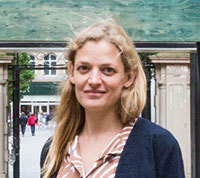
How do you describe what you do when someone in your family asks?
When someone in my family asks, I say I’m an artist who makes work in response to place and who occasionally makes illustrations and often collaborates with other artists, musicians or young people and community groups. It’s sometimes hard to explain because I do lots of different projects all the time, sometimes exhibitions or public artwork and sometimes images for a magazine or a book.
What is the most interesting project you’ve worked on?
The most interesting project I have worked on recently was an artist residency at a big gallery in Liverpool called The Bluecoat. I lived and worked in Liverpool and created a big sculpture outside, in response to the architecture and nature of the building. As part of the process I also collaborated with young people in order to explore the place but also with a team of designer/makers who helped me build the sculpture.
What aspect of your work gives you the best feeling?
Making it. I enjoy the making process a lot. I also enjoy working with other people but I always incorporate a lot of actual making, like building and drawing together.
What keeps you awake at night?
I’m self-employed so sometimes I worry about not having enough work and being able to pay all my bills. Other times I worry whether I have time to do all the projects I have happening at that time. It changes all the time and can sometimes be quite stressful but it also gives me a lot of freedom and the opportunity to work in lots of different places with different people all the time.
What does your work now have to do with what you studied, if at all?
I studied Communication Art and Design at the Royal College of Art. The course was a great mixture of artists and designers. I work in that field in between art and design often. I work on lots of commissions like a designer would do but I also participate in lots of exhibitions. In my work I still explore similar ideas related to architecture and place, as I did at college, so it’s not that different now really.
What advice would you give to a young person interested in a career like yours?
It’s a good idea to research all the different courses and universities out there and find one that suits your area of interest and personality. It’s often helpful to do work experience with an artist or designer in order to try things out and get an idea about the subject you are interested in. I did an Art and Design foundation course at Camberwell College of Arts in London and that was a brilliant way to try out lots of different areas of art and design and helped me work out what I was really interested in.
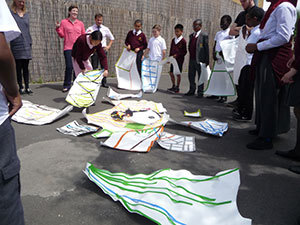
Jasper Sutherland, Designer
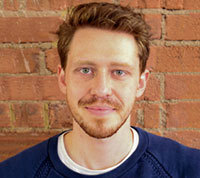
How do you describe what you do when someone in your family asks?
I guess it depends on how long it’s been since I’ve seen them and how long they’ve got! In the broadest sense I’m a designer. I work for make:good, a small community-oriented interdisciplinary design studio. I do a lot of graphics and illustration which is what I studied, but also I design and build sets, places, props, pop-ups and products. The ethos of our studio is to involve people in local change so I also do a lot of work with communities and young people.
What is the most interesting project you’ve worked on?
I used to work in theatre design and I was one of the lead designers for an overnight production of Macbeth. It was set across three floors of the Balfron tower in East London. It was insane and very ambitious – the audience arrived in groups of 10 at 10 minute intervals and had their own apartment for the evening. There were 3 sets of the cast and 9 apartments that we had to decorate and furnish like they were from the 1970s. The budget was tiny – the pay even tinier – the hours were mad and it nearly broke me but the people were wonderful and I had so much fun and the experience was incredible. It is one of the best things I’ve done and I’m really proud of it.
What aspect of your work gives you the best feeling?
I really like making things with my hands and the satisfaction of seeing an idea come into reality. I also really like how varied the different projects are and how varied my role is. I’ve never been happy with the idea of doing the same thing every day – I’m good at and enjoy lots of things so I’m glad I don’t only have to do one thing. I’m more of a generalist than a specialist so this job is perfect for me in that sense. In my job at make:good I also get to work with lots of people from all sorts of backgrounds which is really interesting and rewarding.
What keeps you awake at night?
Very little. I could sleep standing up on a train! I think I’ve had 2 sleepless nights in my entire life. But actually when I was studying and when I do freelance bits I do like working at night. There are no distractions, it’s quiet and you can get into a real flow. If I’m enjoying what I’m doing (or have a deadline looming) I can work straight through till dawn.
What does your work now have to do with what you studied, if at all?
I studied International Relations and Development Studies for my undergraduate degree, but went on to do a Masters in Communications Design studying Illustration and Graphics – which is a big part of what I do now. I learned a lot about visual language and design thinking but a lot of what I bring to my work comes from other experiences too. For me, going back to Uni and studying something creative, more than skills, it gave me the confidence to shift my career and to feel as though I could legitimately identify as a designer, which is quite important.
What advice would you give to a young person interested in a career like yours?
If we talk about career paths my ‘career’ has been very meandering… And the better for it I think. The idea of a career can feel quite pressurised, but I really don’t think everyone has to have a straightforward career path anymore.
<p">Don’t start by getting too hung up on ‘what’ you want to do or even how you’re going to do it. I think it’s really important to think about ‘why’. The sooner you get to know what motivates you the more interesting you’re career becomes. Also don’t worry if you change your mind – there are jobs within really interesting sectors out there that you haven’t even dreamed of and you could end up doing any of them once you get in the door – so really don’t get too hung up on the what.
Make opportunities happen but also be prepared to take them as they come too – also get used to saying yes and learning fast – you can learn almost anything on Youtube. You shouldn’t be scared of making mistakes but let them be because you are pushing yourself, not just being sloppy. My tutor at University always said that we should make more mistakes – because it means you are learning and also that you are trying and taking risks.
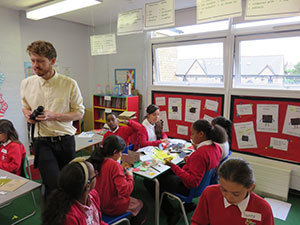
Cultivate Routes
Cultivate Routes was a workshop programme that supported careers education, focusing on creative roles. One in every six jobs in London is in a creative sector - and this is growing - so it’s important for children to know what is possible in their own futures. Following consultation with local teachers, we identified the need to raise aspirations and broaden the horizons of local children and young people through Cultivate Routes - a series of half-day creative careers workshops for groups of up to 30 Primary or Secondary level students. Creative practitioners, freelancers or representatives of small creative businesses visit schools to deliver inspiration sessions for students, tailored to their age and interests.
The following examples are workshops that have been delivered in Wandsworth schools since 2016.
Designer Fatima Khuzem / GCSE Design & Technology / Ark Bolingbroke Academy / Product design & the needs of users
Fatima introduced her own route into design and went through the stages of her career development to show the diversity of different roles, mindsets and work settings in a design career. These included university projects, a design studio, a large company and being a freelancer. Although a product designer, she showed how her different roles have used other design methods or skills such as Spatial Design, Service Design and Graphic Design. For example, developing signage and wayfinding for an airport draws on all three.
A practical challenge was set to design a product for an imagined person. Fatima gave groups a person, a problem and a setting, and students played roles in pairs, one a designer, one the user, questioning them about their problem. The 'users’ included a dyspraxic young person, a lonely 50 year-old and a busy parent, calling for empathy and good questioning techniques. The next steps were to write a design brief, to generate ideas, to select the best ideas, test them and then to sell their idea in a visual presentation. They were encouraged to think like an artist and like a business person.
As an example, one group invented a rotating cycle storage rack for a train station, that would allow bikes to be stored quickly to speed up the commute.
“I enjoyed learning about how to reach and join a product design path and what comes after education. I also enjoyed the designing aspect.” Pupil
“I found out that working together and collecting other people’s opinions and ideas are useful in designing something.” Pupil
“There are an abundance of things you must consider when designing – especially the user.” Pupil
The workshop encouraged open thinking about the role of a designer, the diversity of mindsets and situations you find yourself in. The teacher observed that the students were all engaged, listening and on task, and that they appreciated seeing lots of examples and discovering a wider context for how design is applied. She was pleased that the session explored transferable skills and the importance of collaboration.
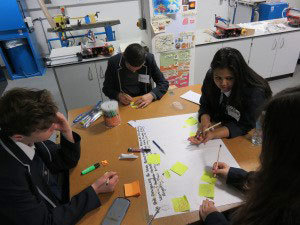
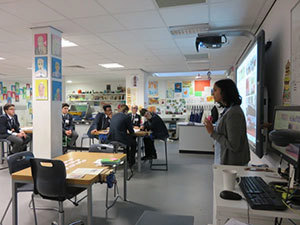
Film-maker Reece Lipman / Chocolate Films / St Mary’s Primary
The workshop explored the different roles involved in making a film and introducing pupils to pre-production tasks, how to craft a story and techniques for shooting. Their task was to make a film with only 5 shots, to fit within a genre such as romance. They watched a film called For the Birds, analysing all the different camera angles and what each shot revealed and concealed. They explored a basic story structure where a hero encounters an obstacle on a journey. Working in teams they made their own storyboards based on this. They used cardboard frames to contain their actions within their scenes, and posed behind them for each of their 5 shots. The session concluded with questions for Reece about how to become a film-maker, and some reflection on what they had learned.
Pupils said they liked having a go at acting and getting their hands on a camera. Some said they enjoyed the elements where they were listening and watching, for example, learning from Reece about film-making and analysing the shots in a film. Some liked the team work.
“I enjoyed acting and watching movies and getting together and doing things we would not usually do.”
“…being a film maker is much cooler than I thought it would have been”
“there are different stages in film life and you don’t just do it all at once”
Teacher Luke Doyle said “the day was an excellent opportunity for the children to learn about the available careers and to get hands on.” He felt the pupils produced some good work, and it was especially good to see boys really enjoying making romantic narratives.
